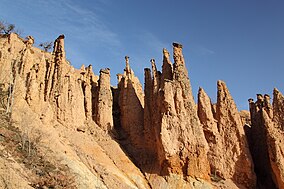Đavolja Varoš
| Đavolja varoš | |
|---|---|
 Đavolja Varoš | |
| Location | Toplica, Serbia |
| Coordinates | 42°59′33″N 21°24′26″E / 42.99250°N 21.40722°ECoordinates: 42°59′33″N 21°24′26″E / 42.99250°N 21.40722°E |
| Area | 0.67 km2 (0.26 sq mi) |
| Elevation | 700 m (2,300 ft) |
| Website | www |
Đavolja varoš (Serbian Cyrillic: Ђавоља варош, lit. "Devil's Town") is a rock formation consisting of about 200 earth pyramids or "towers", located in southern Serbia on the Radan Mountain,[1] in the municipality of Kuršumlija.
Geology[]
Đavolja Varoš features 202 exotic formations described as earth pyramids or "towers", as the locals refer to them. They are 2 to 15 m (6 ft 7 in to 49 ft 3 in) tall and 4 to 6 m (13 to 20 ft) wide at the base. These formations were created by strong erosion of the soil that was scene of intense volcanic activity millions of years ago.[2] Most of the towers have "caps" or "heads" of andesite, which protect them from further erosion.[3] Volatile volcanic history left marks in the multicolored rocks in the towers hinterlands. However, Đavolja Varoš in its modern form is a relatively new feature. As the inhabitants of the surrounding region were cutting down the forests, they enabled for the precipitation to erode the rocks.[4] The area beneath the towers is called The Hell gully (Paklena jaruga) and the surrounding terrain is a location of the mine shafts from the medieval Nemanjić Serbia.[1]
A natural spring is located beneath the formations and has a high mineral concentration. There are two springs: Đavolja voda (Devil's Water), with extremely acidic water (pH 1.5) and high mineral concentration (15 g/l of water), and Crveno vrelo (Red Well).[5] The unusually pungent spring waters were examined for the first time in 1905 by Aleksandar Zega, founder of the Serbian Chemical Society.[1]
Protection[]
The formations were scientifically examined and described in 1955 by .[1] Since 1959, Đavolja Varoš has been protected by the state and a 1995 decision of the Serbian Government declared it a major natural monument subject to category one protection.[5] It is visited by 50,000 tourists yearly.[1]
Đavolja Varoš was a nominee in the New Seven Wonders of Nature campaign.[6]
See also[]
- List of rock formations in Serbia
- Stone town of Kuklica, similar formation in Macedonia
- Bisti/De-Na-Zin Wilderness
- Bryce Canyon National Park
- Demoiselles Coiffées de Pontis
- Hoodoo (geology)
- Kasha-Katuwe Tent Rocks National Monument
References[]
- ^ a b c d e Dragan Borisavljević (8 July 2009), "Đavolja varoš na putu za svetsko čudo", Politika (in Serbian)
- ^ Đavolja varoš Archived 2013-05-08 at the Wayback Machine, National Tourist Organization of Serbia (English)
- ^ The Djavolja Varos (Devil's Town) Natural Landmark, UNESCO World Heritage
- ^ "Da li znate? - Koliko ima kamenih stubova u Đavoljoj varoši?", Politika (in Serbian), 14 November 2016
- ^ a b About Devil's Town, Official website
- ^ New7Wonders: Đavolja Varoš, Rock Formation Archived 2009-07-09 at the Wayback Machine
External links[]
| Wikimedia Commons has media related to Đavolja varoš. |
- Djavolja Varos - Devil's Town About Devil`S Town
- IUCN Category III
- Rock formations of Serbia
- Springs of Serbia
- Tourist attractions in Serbia
- Protected areas of Serbia
- Erosion landforms
- Geology of Serbia
